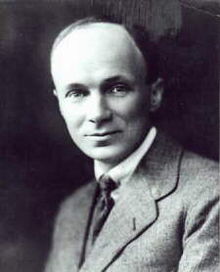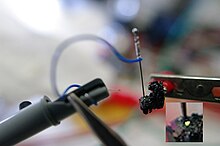利用者:加藤勝憲/ヘンリー J. ラウンド
ヘンリー J. ラウンド Captain Henry Joseph Round | |
|---|---|
 ヘンリー J. ラウンド | |
| 生誕 |
1881年6月2日 Kingswinford, Staffordshire, England |
| 死没 |
1966年8月17日(85歳没) Bognor Regis, England |
| 著名な実績 | radio, light-emitting diode |
ヘンリー・ジョセフ・ラウンドMC(1881年6月2日 - 1966年8月17日)は、イギリスのエンジニアで、ラジオの初期のパイオニアの一人。固体ダイオードからのエレクトロルミネッセンスの観測を最初に報告し、発光ダイオードの発見につながった。グリエルモ・マルコーニの個人秘書を務めた。
ラウンドはジョセフ・ラウンドとガートルード・ラウンドの長男として生まれた。幼少期をスタフォードシャーの小さな町キングスウィンフォードで過ごし、チェルトナム・グラマー・スクールで早期教育を受けた。その後、インペリアル・カレッジ・ロンドンの付属カレッジであるロイヤル・カレッジ・オブ・サイエンスに入学し、第一級の優等学位を得た。
Round was the eldest child of Joseph and Gertrude Round. He spent his early years in the small town of Kingswinford in Staffordshire and received his early education at Cheltenham Grammar School. He later attended the Royal College of Science, a constituent college of Imperial College London where he gained a first class honours degree.
ラウンドがマルコーニ社に入社したのは1902年、マルコーニが大西洋横断無線通信に成功して間もない頃だった。米国に派遣された彼は、粉末鉄芯同調インダクターなどの技術を中心に、無線技術のさまざまな側面を実験した。また、時間帯の異なる陸上と海上での伝送路の実験や、フレーム・アンテナを使った方位測定の研究も行った。
真空管の発明
[編集]ラウンドは最初の真空管の開発に重要な貢献をした。彼はマルコーニの熱電子管の研究プログラムを率い、リー・デ・フォレストが米国でオーディオンを開発していたのとほぼ同時期に、3素子(三極管)増幅管を開発した。アレクサンダー・マイスナー、エドウィン・アームストロングとともに真空管におけるフィードバック(再生)を独自に発見し、最初のAM真空管ラジオ送信機のいくつかを製作した。現在真空管で広く使われている間接加熱式カソードの最初の設計特許を取得。
Round made important contributions to development of the first vacuum tubes. He headed Marconi's research program into thermionic tubes, and developed a three-element (triode) amplifying tube at roughly the same time as Lee De Forest was developing the Audion in the US. He discovered feedback (regeneration) in vacuum tubes independently along with Alexander Meissner and Edwin Armstrong, and built some of the first AM vacuum tube radio transmitters. He patented the first design for an indirectly heated cathode, the type of cathode widely used in vacuum tubes today.
発光ダイオード
[編集]
その後、様々な物質を用いた鉱石検波器の実験で、彼は電流を流し、発光ダイオード(LED)の効果に関する最初の報告である、光を発するものがあることに気づいた[1][2]。 ラウンドは、1907年に『Electrical World』で彼の結果を発表した[3]。
| 「 | エレクトリカル・ワールド』編集部へ:
SIRS- カーボランダムと他の物質の接点に電流が非対称に流れることを調査していたとき、不思議な現象が起こった。カーボランダム結晶の2点間に10ボルトの電位をかけると、結晶は黄色っぽい光を発した。このような低電圧で明るい光を放つ結晶は1つか2つしか見つからなかったが、110ボルトの電圧をかけると多数の結晶が発光した。結晶の端だけが光を放つものもあれば、黄色い光の代わりに緑色、オレンジ色、青色を放つものもあった。テストしたすべてのケースで、光りはマイナス極から来るように見え、プラス極では明るい青緑色の火花が現れた。単結晶の場合、中央付近でマイナス極と接触させ、それ以外の場所でプラス極と接触させると、水晶の一部分だけが光り、プラス極がどこに置かれても同じ部分が光る。 上記の効果と、カーボランダムと他の導体との接合部を直流または交流電流で加熱したときに生じるe.m.f.との間には、何らかの関連があるように思われるが、e.m.f.効果の明らかな説明が熱電効果であることから、この関連は二次的なものに過ぎないのかもしれない。筆者は、この現象やそれに関連する現象の調査について発表されたものがあれば、喜んで紹介したい。 ニューヨーク州ニューヨーク H.J. ラウンド SIRS: – During an investigation of the unsymmetrical passage of current through a contact of carborundum and other substances a curious phenomenon was noted. On applying a potential of 10 volts between two points on a crystal of carborundum, the crystal gave out a yellowish light. Only one or two specimens could be found which gave a bright glow on such a low voltage, but with 110 volts a large number could be found to glow. In some crystals only edges gave the light and others gave instead of a yellow light green, orange or blue. In all cases tested the glow appears to come from the negative pole, a bright blue-green spark appearing at the positive pole. In a single crystal, if contact is made near the center with the negative pole, and the positive pole is put in contact at any other place, only one section of the crystal will glow and that same section wherever the positive pole is placed. There seems to be some connection between the above effect and the e.m.f. produced by a junction of carborundum and another conductor when heated by a direct or alternating current; but the connection may be only secondary as an obvious explanation of the e.m.f. effect is the thermoelectric one. The writer would be glad of references to any published account of an investigation of this or any allied phenomena. New York, N. Y. H. J. Round |
」 |
兵役
[編集]1914年に第一次世界大戦が勃発し、1914年12月、ラウンドは将官名簿に登録され、新設された情報部隊に臨時中尉Intelligence Corps (United Kingdom)の階級で出向した[4]。ラウンドは方位測量の経験を生かし、西部戦線に沿って一連の方位測定所を設置した。
これらの無線方向探知局は非常に成功したため、ドイツの飛行船、船舶、Uボート(潜水艦)の動きを監視するために、一連の無線方向探知局(「Y」局と指定された迎撃局と区別するために「B」局と命名された)がイギリスの海岸線に沿って設置された。1916年5月、同局はヴィルヘルムスハーフェンに停泊中のドイツ海軍からの通信を監視していた。5月30日、放送局は信号の方向が1.5度変化したことを報告した。その結果、イギリス提督はイギリス艦隊に出港してドイツ艦隊と交戦するよう命じた。史上最大の海戦であるジュトランド海戦は、翌日に勃発した。
These wireless direction finding stations proved so successful that a chain of wireless direction finding stations (named 'B' stations to differentiate them from interception stations which were designated 'Y' stations) were installed along the British coastline to monitor the movements of German airships, ships and U-boats (submarines). In May 1916, the stations were monitoring transmissions from the German Navy at anchor at Wilhelmshaven. On 30 May the stations reported a 1.5-degree change in the direction of the signals - suggesting that the ships were on the move. Consequently, the British Admiralty ordered the British fleet to set sail and engage the German fleet. The Battle of Jutland, the largest sea battle of all time, occurred the next day.
1916年9月6日、おそらくはジュトランド海戦への貢献が認められ、またその功績が広く認められ、ラウンドは「[特別]任務に[従事]している間」臨時大尉に任命された[5]。情報部隊の臨時大尉への昇進は、1917年の新年の栄誉で確認された[6]。
On 6 September 1916, possibly in recognition of his contribution to the Battle of Jutland and in wider recognition of his work, Round was appointed as a temporary Captain "while [employed] of [special] duty."[5] Round's promotion to temporary Captain at the Intelligence Corps was confirmed in the 1917 New Year Honours.[6]
1918年5月31日、戦時中の功績が認められ、ラウンドは軍事十字章Military Crossを授与された[7]。
戦後、民間に戻ったラウンドは無線送信機に携わるようになり、イギリス初の放送に大きく関わった。ラウンドは1921年にマルコーニ無線電信会社のチーフ・エンジニアとなったが、数年後、自身のコンサルタント会社を設立するために退社した。 Marconi's Wireless Telegraph Company in 1921, but some years later he left to set up his own consultancy.
1939年に第二次世界大戦が勃発すると、英国政府は再び彼のサービスを求めた。このとき彼は、今日ソナーとして知られているASDIC(対潜水艦探知調査委員会)に携わった。
ASDIC (Anti-Submarine Detection Investigation Committee) which is known today as sonar.
晩年
[編集]1961年、おそらく彼の80歳の誕生日を記念して、ジャンヌ・D・ラウンドが「H.J.ラウンド大尉、M.C.」のブロンズ胸像を制作。現在はBAEシステムズが所有し、チェルムスフォード博物館Chelmsford Museumの一部であるサンドフォード・ミルに貸与されている[8]。ラウンドは短い闘病生活の後、1966年8月にボグナー・リージスの老人ホームで85歳で死去した。
脚注・参考文献
[編集]- ^ Shubert, E. Fred (2003), Light-Emitting Diodes, Cambridge University Press, p. 1, ISBN 0-521-82330-7, "The first light-emitting diode (LED) had been born."
- ^ Zheludev, Nikolay (2007). “The life and times of the LED – a 100-year history”. Nature Photonics 1 (4): 189–192. Bibcode: 2007NaPho...1..189Z. doi:10.1038/nphoton.2007.34 11 April 2007閲覧。.
- ^ Round, H. J. (1907), “A note on carborundum”, Electrical World 49: 309. Round's letter is dated 9 February 1907.
- ^ “Supplement to the London Gazette”. The London Gazette (29141): 4034. (23 April 1915) 5 January 2021閲覧。.
- ^ “Supplement to the London Gazette”. The London Gazette (29781): 9845. (10 October 1916) 5 January 2021閲覧。.
- ^ “Supplement to the London Gazette”. The London Gazette (29886): 40. (29 December 1916) 5 January 2021閲覧。.
- ^ “The London Gazette”. The London Gazette (30729): 6673. (4 June 1918) 5 January 2021閲覧。.
- ^ “Henry Joseph Round (1881–1966), Radio Engineer and Inventor | Art UK” (英語). artuk.org. 5 January 2021閲覧。
関連文献
[編集]- Poole, Ian. HJ Round – the unknown genius. Electronics World, May 2003, p. 21
- Morse, A. H. (1925), Radio: Beam and Broadcast, Ernest Benn Limited. History of radio in 1925.
- Marconi Calling Archived 4 March 2016 at the Wayback Machine.
- The Life of Captain H J Round
[[Category:1966年没]] [[Category:1881年生]]
